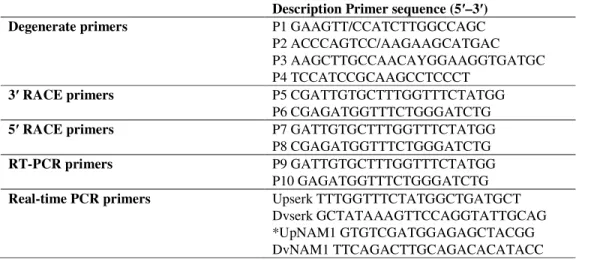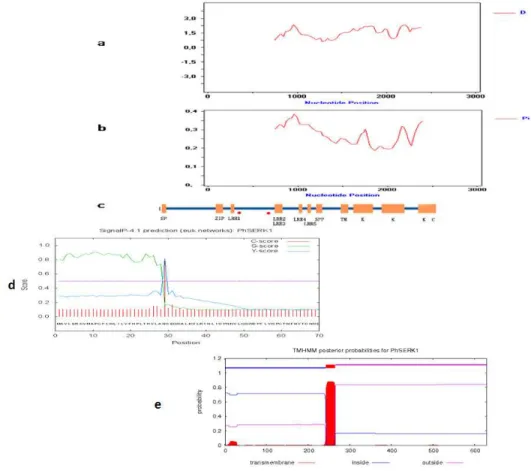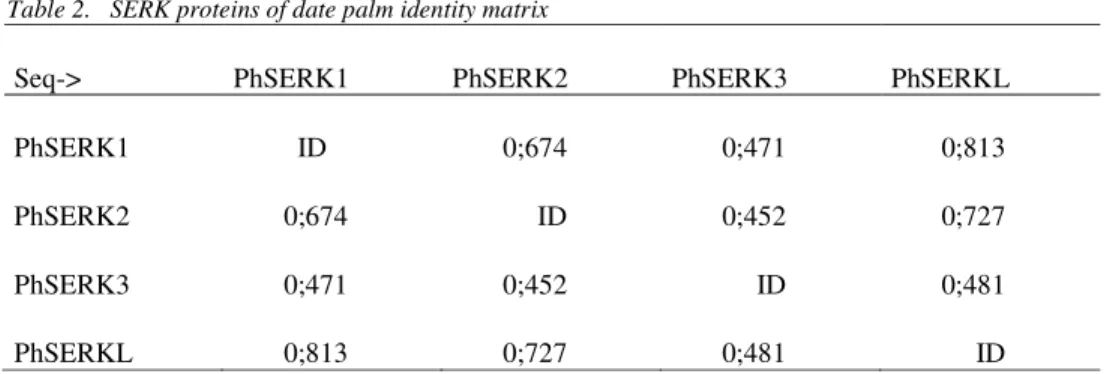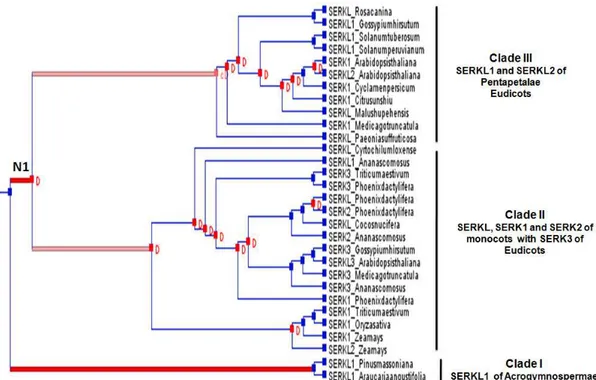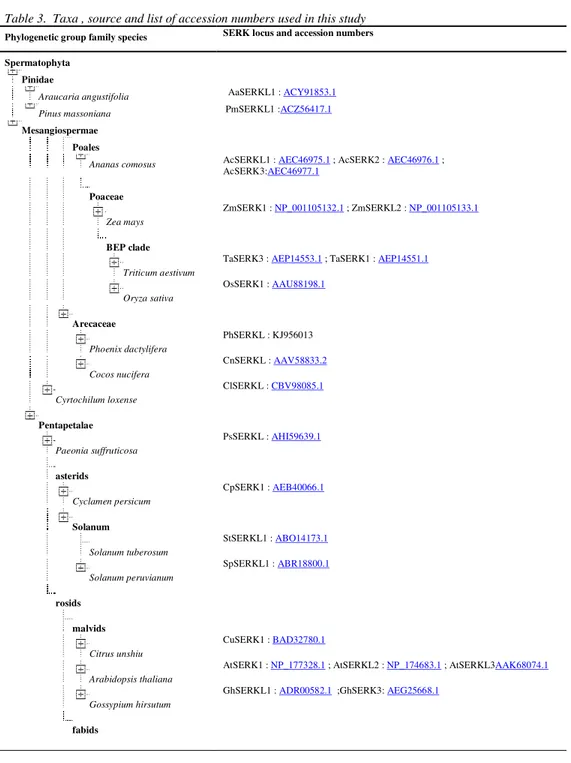___________________________
Corresponding author:Imen Rekik,, Laboratory of plant biotechnology, Faculty of sciences of Sfax, University of Sfax. Tunisia,Tel: 0021674676616, Fax: 0021674274437, Email :
imenbmc@yahoo.fr
UDC 575
DOI: 10.2298/GENSR1501323R
Original scientific paper
MOLECULAR CHARACTERIZATION AND EVOLUTION STUDIES OF A SERK LIKE GENE TRANSCRIPTIONALLY INDUCED DURING SOMATIC EMBRYOGENESIS IN
Phoenix Dactylifera L v Deglet Nour
Imen REKIK1, Noureddine DRIRA1, C. Douglas GRUBB2, and Amine ELLEUCH1
1Laboratory of plant biotechnology, Faculty of sciences of Sfax, University of Sfax. Tunisia 2Leibniz Institute of Plant Biochemistry, Halle, Germany
Rekik I., N. Drira, C. D. Grubb, and A. Elleuch (2015): Molecular characterization and evolution studies of a SERK like gene transcriptionally induced during somatic embryogenesis in Phoenix Dactylifera L v Deglet Nour.- Genetika, Vol 47, No. 1, 323-337.
A somatic embryogenesis receptor kinase like (SERKL) cDNA, designated PhSERKL, was isolated from date palm (Phoenix Dactylifera L) using RACE PCR. PhSERKL protein shared all the characteristic domains of the SERK family, including five leucine-rich repeats, one proline-rich region motif, a transmembrane domain, and kinase domains. Phylogenetic analyses using PHYLIP and Notung 2.7 programs suggest that the SERKproteins of some plant species resulted from relatively ancient duplication events. We predict an ancestor protein of monocots and dicots SERK using FASTML program. Somatic embryogenic cultures of date palm were established following transfer of callus cultures to medium containing 2, 4-dichlorophenoxyacetic acid. The role of PhSERKL gene during establishment of somatic embryogenesis in culture was investigated using quantitative real-time PCR. PhSERKL gene was highly expressed during embryogenic competence acquisition and globular embryo formation in culture. Overall, levels of expression of PhSERKL gene were lower in nonembryogenic tissues and organs than in embryogenic callus.
Key words:duplication, expression pattern, Phoenix dactylifera, SERKL
INTRODUCTION
The first somatic embryo development in vitro was demonstrated by both REINERT (1958) and
STEWARD et al (1958). Somatic embryogenesis (SE) is an in vitro regeneration system whereby an
organized bipolar structure containing root and shoot apices, and morphologically resembling a zygotic embryo, is formed from one somatic cell. Somatic embryogenesis involves various molecular events including differential gene expression and various signal transduction pathways for activating or repressing numerous genes sets (CHUGH and KHURANA 2002). Genes involved in somatic embryogenesis are stage specific. The first somatic embryogenesis receptor like kinase (DcSERKL) is identified in early somatic embryogenesis and was originally isolated from embryogenic cells in suspension cultures of the dicot Daucus carota (SCHMIDT et al., 1997). SERK belongs to the Leucine rich repeat, receptor-like kinases (LRR-RLKs), a subgroup of protein kinases characterized by an extracellular domain with at least five Leu-rich repeats (LRRs), a transmembrane domain, and an intracellular kinase domain. The putative role of RLKs in developmental processes is to transduce environmental signals and/or information from neighboring cells and to induce specific responses (BAUDINO et al., 2001). The gene ZmSERK was isolated from maize, and its expression patterns were similar to DcSERK during SE, but it showed a more diverse expression pattern than that of DcSERK and AtSERK1 (BAUDINO et al., 2001). These results indicated that SERK plays an important role in SE, and it can be used as a marker of embryogenic competence.
Date palm (Phoenix dactylifera L. 2n = 36), famed for its sugar-rich fruits (dates) and cultivated by humans since 4000 B.C, is an economically important crop in the Middle East, Northern Africa and increasingly other places where climates are suitable. Despite a long history of human cultivation, the understanding of date palm genetics and molecular biology is rather limited, hindered by a lack of basic high quality data from genomics and transcriptomics. To ensure the renewal and extension of date palm groves, in vitro micropropagation techniques have been developed from zygotic embryos, axillary buds, immature leaves and mature flowers (TISSERAT, 1979; DRIRA et al., 1983; MASMOUDI et al., 2009). Date palm micropropagation through somatic embryogenesis has been previously reported (HUONG et al., 1999; KRIAA et al., 2012). The use of embryogenic suspension cultures improved the yields in the regeneration processes and allowed large-scale propagation of several date palm cultivars (FKI et al., 2003). However, the efficiency of various somatic embryogenesis protocols described for date palm depends on the nature of the explants and the genetic characteristics to each cultivar, some of them being recalcitrant to in vitro culture (KRIAA et al., 2012). During somatic embryogenesis, biochemical and morphological changes occur throughout the development of induced tissues (SHARP et al., 1980), which are strongly related to modification of gene expression patterns (ZIMMERMAN et al., 1993).
In this study, we first isolated a SERKL cDNA (PhSERKL) from date palm. Few SERK-like genes have also been reported. We also investigated the molecular evolutionary history of
plants SERKgenes to gain further understanding of the evolutionary dynamics of nuclear gene families.
MATERIALS AND METHODS In vitro culture conditions
medium acting as negative control for real-time PCR. Batches of cultured callus were periodically used to extract total RNA for the relevant stage after 0, 10, 15, 25, 30, 35, 40, 45, 50 and 60 days incubation on 2,4-D containing medium. Negative control callus samples were taken from callus cultured without 2, 4-D at 0, 15, 25, 35, and 45 days. Various organs (root, stem, leaf, ovule and bract) were used to extract total RNA to detect PhSERKL expression level by real-time PCR.
RNA/DNA extraction and cDNA synthesis
Total RNA extraction was carried out using TRIZOL reagent (Takara). Poly (A) + RNA was isolated from total RNA using an mRNA Purification Kit (Takara). For first strand cDNA synthesis, 2 g of Poly (A) + RNA was reverse transcribed in a final volume of 20 l using oligo (dT) 18 and M-MLV reverse transcriptase (Invitrogen). Genomic DNA was extracted from tissues cultured in vitro using cetyltrimethyl ammonium bromide and treated with RNase A.
Cloning of PhSERKL cDNA
Degenerate primers (P1, P2, P3, and P4, listed in Table 1) designed based on conserved SERK regions were employed to amplify SERK fragments. The 5 and 3 sequences of SERK were amplified by rapid amplification of cDNA ends (RACE) using the 3 -Full RACE Core Set Ver.2.0 kit and 5 -Full RACE Core Set Ver.2.0 kit (Takara). The nested gene-specific primers for 3 RACE were P5–P6 (Table1). Reactions were carried out following the PCR procedure: initial denaturation at 94 °C for 3 min, subsequent denaturation at 94 °C for 30 s, annealing at Tm °C for 30 s, extension at 72 °C for 1 min, 30 cycles, and the final extension at 72 °C for 10 min. The primers for 5 RACE were P7–P8 (table1). The thermal cycle programs were: 94 °C for 5 min, 35 cycles at 94 °C for 45 s, Tm °C for 45 s, 72 °C for 1 min, followed by final extension at 72 °C for 10 min. Sequences were edited, aligned, and analyzed using DNAMAN and Clustal software tools. Specific primers P9 and P10 were designed according to the results of the RACE to amplify the full-length cDNA sequence and the genomic sequence.
Table 1. Details of primers used in the study
* no apical meristem (NAM)
Description Primer sequence (5 –3 )
Degenerate primers P1 GAAGTT/CCATCTTGGCCAGC
P2 ACCCAGTCC/AAGAAGCATGAC P3 AAGCTTGCCAACAYGGAAGGTGATGC P4 TCCATCCGCAAGCCTCCCT
3 RACE primers P5 CGATTGTGCTTTGGTTTCTATGG
P6 CGAGATGGTTTCTGGGATCTG
5 RACE primers P7 GATTGTGCTTTGGTTTCTATGG
P8 CGAGATGGTTTCTGGGATCTG
RT-PCR primers P9 GATTGTGCTTTGGTTTCTATGG
P10 GAGATGGTTTCTGGGATCTG
Real-time PCR primers Upserk TTTGGTTTCTATGGCTGATGCT
Bioinformatics analysis
The open reading frame (ORF) was predicted using the “ORF Finder” program (http://www.ncbi.nlm.nih.gov/gorf/gorf. html). The signal peptide was predicted by using the “SignalP3.0 Server” tool (http://www.cbs.dtu.dk/servicesSignalP/).The transmembrane region (TM) was predicted by TMHMM (http://www.cbs.dtu.dk/services/TMHMM/). Multiple sequence alignment was performed with ClustalW. We predicted tertiary structure with ligand binding sites
of the protein PhSERKL using the program 3D LigandSite
(http://www.sbg.bio.ic.ac.uk/3dligandsite). We also used InterPro (http://www.ebi.ac.uk/interpro/) and ScanProsite (http://us.expasy.org/prosite/) to analyze the functional structure of the PhSERKL protein. Detection of potential recombination between mRNA sequences was carried out using RDP (Recombination Detection Program) version 3.0 (MARTIN et al., 2010). Nucleotide diversity ( ) and Tajima’s D (TAJIMA, 1989) were calculated using DNAsp 5.10 (LIBRADO and ROZAS 2009). The phylogenetic relationships between the SERK genes for different species were analyzed using the maximum-likelihood (ML) method. For the ML analyses, we used the PROTML program of PHYLIP version 3.6 (FELSENSTEIN, 2000). We employed the JTT model of amino acid substitution. All indels were counted as missing. We performed ten random sequence addition searches using the J option and global branch swapping using the G option to isolate the ML tree with the best log-likelihood. In addition, we performed bootstrap analysis with 1000 replications. To infer the evolutionary events affecting the SERK genes, an analysis using Notung 2.7 (CHEN et al., 2000) was performed. The ML tree with the highest log-likelihood was used for the gene tree. Both gene duplications and losses were considered to reconcile the gene tree with the species tree. Ka (the number of nonsynonymous differences divided by the number of nonsynonymous sites) and Ks (the number of synonymous differences divided by the number of synonymous sites) and Tajima’s D (TAJIMA 1989) were calculated using DNAsp 5.10 (LIBRADO and ROZAS 2009). DNAsp uses the method of NEI and GOJOBORI (1986) to identify synonymous and nonsynonymous sites and a Jukes–Cantor correction is applied for multiple hits. Ancestral sequences were calculated for SERK protein of monocots and dicots using the FastMLweb server (
http://fastml.tau.ac.il/ ).
Quantitative real-time PCR analysis
Real-time PCR has been used for gene expression studies in many species (CHAI et al., 2010; MA et al., 2010; QI et al., 2010). The relative expression of PhSERKL was measured using Thunderbird SYBR qPCR Mix (Toyobo) performed on the iQ5 real-time PCR System (Biorad). A gene encoding a Phoenix dactylifera no apical meristem-related protein (NAM1) was used as the endogenous control (ADAM et al., 2011). To prevent amplification of any contaminating genomic DNA, RNA preparations were treated with DNase I, and the probe primers were designed over an exon/intron boundary in the cDNA sequence. Specificity of the amplifications was verified by electrophoresis and at the end of the PCR run by melt curve analysis. Primer sequences used for PhSERKL and endogenous control are listed in table 1. Real-time PCR results were analyzed using the iQ5 System Software. Tissue samples were prepared as described in “In vitro culture conditions” section.
RESULTS AND DISCUSSION Cloning of PhSERKL cDNA
generated a 1.7 kb contiguous fragment. Basic Local Alignment Search Tool (BLAST) searches with this fragment returned several hits matching SERK conserved domains, and the assembled sequence was putatively designated as a date palm SERK (PhSERKL) fragment. Specific primers designed from the putative PhSERKL fragment were used to amplify both 5 and 3 ends of PhSERKL cDNA by RACE PCR. A full-length cDNA sequence comprising 1890 bp, generated by specific primers designed from the sequences yielded by RACE, was defined as PhSERKL and has been submitted to GenBank (accession number: KJ956013). Using the same primers as for the cDNA, the full-length genomic sequence of PhSERKL comprising 6.345 bp was also isolated.
A BLASTN search of this sequence resulted in several SERK similarity hits from other plant species. Nucleotide diversity ( ) and Tajima’s D were calculated for different regions of SERK mRNA from various species of plants (Fig.1a and Fig.1b). This figure shows that the value of is very high in the first part of the sequence (up to 1000 bp) in the ClustalW alignment of SERK mRNA, with gaps that corresponds to the first domains of SERK proteins (SP, LZ, SPP, and TM). The kinase domain (1000 -2000 bp) shows a very low value and a strong positive Tajima’s D, underscoring the high degree of conservation of the SERK gene in the kinase domain (822 bp).
The PhSERKL ORF and relationship to other family members
Table 2. SERK proteins of date palm identity matrix
Seq-> PhSERK1 PhSERK2 PhSERK3 PhSERKL
PhSERK1 ID 0;674 0;471 0;813
PhSERK2 0;674 ID 0;452 0;727
PhSERK3 0;471 0;452 ID 0;481
PhSERKL 0;813 0;727 0;481 ID
Divergence at Synonymous and Nonsynonymous Sites of PhSERKL with plants SERKs mRNA To explore whether Darwinian positive selection was involved in driving gene divergence after duplication, we calculated the nonsynonymous/synonymous substitution ratio (ka /ks) for the coding region of some recently duplicated paralogs using a sliding window of 20 amino acids. Generally, ka: ks>1 indicates positive selection, ka:ks< 1 indicates negative or purifying selection, and a ratio= 1 indicates neutral evolution (WANG et al., 2005).
‘ For the SERK paralogs, ka:ks ratios were always near zero for kinase domain, the conserved SERK domain, suggesting strong purifying selection on this motif. In contrast, many higher ka/ks ratios (ka:ks>1) were generally found in the regions outside the kinase domain, especially in the intermotif regions. Such positive selections have also been observed in the RLK/Pelle gene family in Arabidopsis and rice (SHIU et al., 2004). A higher proportion of new exons had ka:ks>1 and a higher frequency of insertions/deletions (indels) than did the old exons, implying that positive selection played an important role in the evolution of new domains (WANG et al., 2005). Therefore, positive selection is one of the major driving forces for the emergence of new motifs/functions in protein after gene duplication.
Gene duplication of SERK genes in plants
The palm family emerged ~80 million years ago and as such it represents one of the lineages that radiated early in monocot evolution (WILSON et al., 1990; DUVALL et al., 1993). The comparative analysis of PhSERKL protein of date palm with others species presents an ideal opportunity to investigate the dynamics of angiosperm gene family evolution, and in particular, to expand our understanding of the evolution of the SERK gene family.
duplication events (Fig.2). We observe that multiple independent duplication events have occurred throughout the evolutionary history of the SERK family. Based on the reconciled phylogeny (Fig.2), we estimate 15 independent gene duplication, 1 coduplication and 50 gene loss events during the diversification of this gene family. The clade I and clade II arose from at least one major duplication events to obtain the SERKL1 and SERKL2 of Pentapetalae (Eudicots) and SERK of monocots with SERK3 of Eudicots (Fig.2). The ancestor SERK protein of monocots and dicots is shown in Figure 3. The clade III is composed of SERKL1 of Acrogymnospermae diverged from ancestral duplications (Fig.2).
Table 3. Taxa , source and list of accession numbers used in this study
Phylogenetic group family species SERK locus and accession numbers
Spermatophyta
Pinidae
Araucaria angustifolia AaSERKL1 : ACY91853.1
Pinus massoniana PmSERKL1 :ACZ56417.1
Mesangiospermae
Poales
Ananas comosus AcSERKL1 : AEC46975.1 ; AcSERK2 : AEC46976.1 ; AcSERK3:AEC46977.1
Poaceae
Zea mays
ZmSERK1 : NP_001105132.1 ; ZmSERKL2 : NP_001105133.1
BEP clade
Triticum aestivum
TaSERK3 : AEP14553.1 ; TaSERK1 : AEP14551.1
Oryza sativa
OsSERK1 : AAU88198.1
Arecaceae
Phoenix dactylifera
PhSERKL : KJ956013
Cocos nucifera
CnSERKL : AAV58833.2
Cyrtochilum loxense
ClSERKL : CBV98085.1
Pentapetalae
Paeonia suffruticosa
PsSERKL : AHI59639.1
asterids
Cyclamen persicum
CpSERK1 : AEB40066.1
Solanum
Solanum tuberosum
StSERKL1 : ABO14173.1
Solanum peruvianum
SpSERKL1 : ABR18800.1
rosids
malvids
Citrus unshiu
CuSERK1 : BAD32780.1
Arabidopsis thaliana
AtSERK1 : NP_177328.1 ; AtSERKL2 : NP_174683.1 ; AtSERKL3AAK68074.1
Gossypium hirsutum
GhSERKL1 : ADR00582.1 ;GhSERK3: AEG25668.1
Rosaceae
Malus hupehensis MhSERKL : AFP25205.1 Rosa canina RcSERKL : ADM94278.1
Medicago truncatula MtSERK3 : ADO15298.1 ; MtSERK1 : AAN64293.1
Expression Analysis
According to DRIRA & BENBADIS (1985), SE was induced by transferring nonembryogenic callus generated from the leaf base by 60 days of incubation on a medium without 2,4-D, to the medium containing 2,4-D. PhSERKL expression was analyzed by real-time PCR, and tissue samples were derived as described in the “Plant Material” Section. The results obtained showed that PhSERKL is expressed during SE with two peaks of expression at different times (Fig.4). The first peak of expression occurred at 15 days of culture in 2,4-D-containing medium. This coincided with the appearance of the cytological features of calli with embryogenic potential, and embryogenic cells can be found in these calli (HE et al., 2010).
Figure 4. Relative expression of PhSERKL measured using real-time PCR Embryogenic callus shows PhSERKL expression in callus cultured on 2;4-D containing medium; Nonembryogenic callus shows PhSERKL expression in callus cultured on medium without 2;4-D used as negative control; Different organs show PhSERKL expression in different organs
competence and the development of the globular embryo is similar to the SERKs above. This is suggestive of a broader role of PhSERKL in cell reproduction and organ formation, rather than embryogenesis alone in date palm, similar to the cases of AcSERK1 (JUN MA et al., 2012), ZmSERK1 (BAUDINO et al., 2001) and StSERK1 (SHARMA et al., 2008) in potato. The transcript levels of PhSERKL in somatic organs and ovules were moderate, and the lowest abundance was found in anthers. This result coincided with the expression pattern of TaSERK in T. aestivum (SINGLA et al., 2008).
CONCLUSION
In this study, the full length cDNA of a date palm SERKL gene (PhSERKL) has been isolated from a cDNA library prepared from induced callus and the sequence of the PhSERKL protein has been predicted. Based on structural and functional similarity, PhSERKL is likely an orthologue of AcSERK1 and CnSERK, and acts as a key component mediating somatic embryogenesis. Our phylogenetic and genetic evolutionary analysis confirmed that PhSERKL belongs to a gene family in some of the studied species and resulted from a relatively ancient duplication event. These studies could further reveal the function of date palm SERKs and help the establishment of a highly effective in vitro propagation and transformation system of date palm.
ACKNOWLEDGMENTS
This work was supported by grants from the Tunisian minister of Higher Education and Scientific Research
Received December 12th, 2014
Accepted February 25th, 2015 REFERENCES
ADAM, H. , M. MARGUERETTAZ , R. QADRI, B. ADROHER, F. RICHAUD, M. COLLIN, A.C. THUILLET, Y. VIGOUROUX, P. LAUFS, J.W. TREGEAR, S. JOUANNIC (2011): Divergent expression patterns of miR164 and CUP-SHAPED COTYLEDON genes in palms and other monocots: implication for the evolution of meristem function in
angiosperms. Mol. Biol Evol; 28:1439-54.
ALBRECHT, C. E. RUSSINOVA, B. KEMMERLING, M. KWAAITAAL., S.C. DE VRIES (2008): Arabidopsis somatic embryogenesis receptor kinase proteins serve brassinosteroid-dependent and -independent signaling pathways. Plant Physiol; 148:611–619.
BAUDINO, S. S HANSEN, R. BRETTSCHNEIDER, V.R.G. HECHT, T. DRESSELHAUS, H. LORZ, C. DUMAS, P.M. ROGOWSKY (2001): Molecular characterization of two novel maize LRR receptor-like kinases, which belong to the SERK gene family. Planta; 213: 1–10.
CHAI. L. J., M.K. BISWAS, GE. X.X, X. DENG (2010): Isolation, characterization, and expression analysis of an SKP1-like gene from ‘Shatian’ pummelo (Citrus grandisOsbeck). Plant Mol Biol Rep; 28:569–577.
CHEN, K.D., M. DURAND, FARACH-COLTON (2000): NOTUNG: a program for dating gene duplications and optimizing gene family trees. J. Comput. Biol; 7: 429–447.
CHUGH. A. P. KHURANA (2002): Gene expression during somatic embryogenesis-recent advances. Curr Sci; 836: 715–730.
DRIRA, N. and A BENBADIS (1985) : Mulitiplication végétative du palmier dattier (Phoenixdactifera L.) par réversion en culture in vitro d’ebauches florales de pieds femelles. J.plant physiology; 119 :227 – 235.
DRIRA (1983) : Multiplication végétative du palmier dattier (Phoenix dactifera L.) par la culture in vitro de bourgeons axillaires et de feuilles qu’en dérivent. C. R. Biologie; 296: 1052- 1077.
DUJON, B, D. SHERMAN, G. FISCHER, P. DURRENS, S. CASAREGOLA, I,LAFONTAINE, J.,DE MONTIGNY. C. MARCK, C.
FELSENSTEIN, J. (2000): PHYLIP: Phylogeny Inference Package, version 3.6 (alpha).University of Washington, Seattle, USA.
FKI, L. R. MASMOUDI, N. DRIRA, A. RIVAL (2003): An optimised protocol for plant regeneration from embryogenic suspension cultures of date palm, Phoenix dactylifera L. cv. Deglet Nour .Plant Cell Reports; 21: 517–524. HANKS, S.K, A.M. QUINN, T. HUNTER (1988): The protein kinase family: conserved features and deduced phylogeny of the
catalytic domains. Science; 241:42–52
HE, Y.H., S.Q, FANG, J MA, Z.Y HU, M. LU, B. PENG (2010): Histocytology observation on the somatic embryogenesis in Ananas comosus callus. Acta Hortic Sinica; 37:689–696 (in Chinese).
HECHT, V., J.P. VIELLE-CALZADA, M.V. HARTOG, E.D.L SCHMIDT, K.,BOUTILIER, U. GROSSNIKLAUS, S.C. DE VRIES (2001): The Arabidopsis somatic embryogenesis receptor kinase 1 gene is expressed in developing ovules and embryos and enhances embryogenic competence in culture. Plant Physiol; 127:803–816
HUANG. X.,X.Y. LU, J.T. ZHAO, J.K. CHEN, X.M. DAI, W. XIAO, Y.P. CHEN, Y.F. CHEN, X.L. HUANG (2010): MaSERK1 gene expression associated with somatic embryogenic competence and disease resistance response in banana (Musa spp.). Plant Mol Biol Rep; 28: 309–316.
HUONG, L.T., M. BAIOCCO, B.P. HUY, B.MEZZETTI, R. SANTILOCCHI, P. ROSATI (1999): Somatic embryogenesis in Canary Island date palm. Plant Cell; 56: 1–7.
JUN, MA., H. YEHUA, W. CHENGHOU, L, HEPING, H. ZHONGYI, S. GUANGMING (2012): Cloning and Molecular Characterization of a SERK Gene Transcriptionally Induced During Somatic Embryogenesis in Ananascomosus cv. Shenwan. Plant Mo l Biol Rep; 30:195–203.
KRIAA, W., H.B. SGHAIER, A. F. MASMOUDI, M. R. BENJEMAA, N. DRIRA (2012): The date palm (Phoenix dactylifera L.) micropropagation using completely mature female flowers. CR Biol; 335:194–204.
KUMAR, K., S. MARUTHASALAM, M. LOGANATHAN. D. SUDHAKAR, P. BALASUBRAMANIAN (2005): An improved Agrobacterium-mediated transformation protocol for recalcitrant elite indica rice cultivars. Plant Mol Biol Rep; 23: 67–73.
LIBRADO, P., J. ROZAS (2009): DnaSP v5: a software for comprehensive analysis of DNA polymorphism data. Bioinformatics; 25: 1451–1452.
MA, J.F., X.L HOU, D. XIAO, L. QI, F. WANG, F.F. SUN, Q .WANG (2010): Cloning and characterization of the BcTuR3 gene related to resistance to turnip mosaic virus (TuMV) from non-heading Chinese cabbage. Plant Mol Biol Rep; 28: 588–596
MARTIN, D.P., P. LEMEY, M. LOTT, V. MOULTON, D. POSADA, P. LEFEUVRE (2010): RDP3: a flexible and fast computer program for analyzing recombination. Bioinformatics; 26: 2462-2463.
MASMOU. A.F., R.A. CHÂARI, W. KRIAA, B.R. GARGOURI, S.M. JAIN, N. DRIRA (2009): In vitro hermaphrodism induction in date palm female flower. Plant Cell Rep; 28: 1–10.
MATHEWS, S., D.J. DONOGHUE (1999): The root of angiosperm phylogeny inferred from duplicate phytochrome genes. Science; 286: 947-950.
NAGAR, B., O. HANTSCHEL, M. SEELIGER, J.M. DAVIES, W.I. WEIS, F.G. SUPERTI, J KURIYAN (2006): Organization of the SH3-SH2 unit in active and inactive forms of the c-Abl tyrosine kinase. Mol Cell; 21: 787–798.
NEI, M., T. GOJOBORI (1986): Simple methods for estimating the numbers of synonymous and nonsynonymous nucleotide substitutions. Mol. Biol. Evol; 3 :418–426.
QI, J.N., SC.YU. FL. ZHANG, XQ SHEN, XY ZHAO, YJ YU, DS ZHANG (2010): Reference gene selection for real-time quantitative polymerase chain reaction of mRNA transcript levels in Chinese cabbage (Brassica rapa L. ssp. pekinensis). Plant Mol Biol Rep; 28:597–604.
REINERT,J. (1958): Morphogenese und ihre kontrolle an gewebekulturen aus carotten. Naturwissenchaften; 45: 344–345. REKIK, I., E. AMINE, K. WALID, D. NOUREDDINE (2013): Molecular cloning and in silico analysis of three somatic
embryogenesis receptor kinase mRNA from date palm. Genetika; 45: 837-853.
SANTOS, M.O., E. ROMANO, K.S.C YOTOKO, M.L.P TINOCO, B.B.A DIAS, F.J.L ARAGÀO (2005): Characterization of the cacao somatic embryogenesis receptor-like kinase (SERK) gene expressed during somatic embryogenesis. Plant Sci; 168: 723–729.
SCHMIDT, E.D.L. F. GUZZO. M.A.J. TOONEN. S.C. DE VRIES (1997): A leucine rich repeat containing receptor-like kinase marks somatic plant cells competent to form embryos. Development; 124: 2049–2062.
SHAH, H. T.W.J GADELLA, H. ERP, V.,HECHT, S.C, DE VRIES (2001a): Subcellular localization and oligomerization of the Arabidopsis thaliana somatic embryogenesis receptor kinase 1 protein. J Mol Biol; 309: 641–655.
SHAH, K. J. VERVOORT., S.C. DE VRIES (2001b): Role of threonines in the Arabidopsis thaliana somatic embryogenesis receptor kinase 1 activation loop in phosphorylation. J BiolChem ; 276: 41263– 41269.
SHARMA, S.K. S. MILLAM, I. HEIN, GJ BRYAN (2008): Cloning and molecular characterization of a potato SERK gene transcriptionally induced during initiation of somatic embryogenesis. Planta; 228: 319 –330.
SHARP, WR., M.R SONDHAL, L.S CALDAS, S.B MARAFFA (1980): The physiology of in vitro asexual embryogenesis. Horticult; 2: 47–54.
SHIU, S.H., W.M KARLOWSKI, R. PAN; Y.H, TZENG, K. MAYER, W.H LI (2004): Comparative analysis of the receptor-like kinase family in Arabidopsis and rice. Plant Cell; 16: 1220–1234.
SINGLA, B., J.P. KHURANA. P. KHURANA (2008): Characterization of three somatic embryogenesis receptor kinase genes from wheat; Triticum aestivum. Plant Cell Rep; 27:833–843.
STEWARD, F.C, M.O. MAPES, K MEARS (1958): Growth and organized development of cultured cells: II. Organization in cultures grown from freely suspended cells. Am J Bot; 45: 705–708.
TAJIMA, F. (1989): Statistical Methods for Testing the Neutral Mutation Hypothesis by DNA Polymorphism. Genetics; 123: 585-595.
TISSERAT, B. (1979): Propagation of date palm (Phoenix dactyliferaL.) in vitro. Journal of Experimental Botany; 30: 1275– 1283.
WALKER, J.C. (1994): Structure and function of the receptor-like protein kinases of higher plants. Plant Mol Biol; 26: 1599 –1609.
WANG, W., H. ZHENG, S. YANG, H. YU, J. LI, H. JIANG, J. SU, L. YANG, J. ZHANG, J. MCDERMOTT (2005): Origin and evolution of new exons in rodents. Genome Res; 15: 1258–1264.
WU, S.J., H.H., WANG, F.F, LI, T.Z. CHEN, J. ZHANG, Y. J. JIANG, Y.Z. DING, W.Z. GUO, T.Z ZHANG (2008): Enhanced Agrobacterium-mediated transformation of embryogenic calli of upland cotton via efficient selection and timely subculture of somatic embryos. Plant Mol Biol Rep; 26: 174–185.
MOLEKULARNA KARAKTERIZACIJA I EVOLUCIONA ISPITIVANJA SERK LIKE GENA INDUKOVANIH U TOKU TRANSKRIPCIJE U TOKU SOMATSKE
EMBRIOGENEZE kod Phoenix Dactylifera L v Deglet Nour
Imen REKIK1, Noureddine DRIRA1, C. Douglas GRUBB2, Amine ELLEUCH1
1
Laboratorija biotehnologije biljakaFakultet prirodnih nauka Univerzitet Sfax,Tunis 2 Lajbnic Institut biljne biotehnologije, Halle, Nema ka
Izvod
Izvršena je izolacija cDNA receptor kinase like (SERKL), ozna ene kao PhSERKL, u toku somatske embriogeneze datule-urme (Phoenix Dactylifera L.) primenom RACE PCR. PhSERKL protein deli sve karakteristike domena SERK familije, uklju uju i pet repetitivnih sekvenci bogatih leucinom, jedan motiv region bogat prolinom, transmembranski domen i domene kinaze. Filogenetske analize koriš enjem PHYLIP i Notung 2.7 programa sugerišu da SERK protein nekih biljnih vrsta rezultiraju iz relativno starih doga aja duplikacije. Predvideli smo zajedni kog pretka SERK proteina kod monokotiledonihi i dikotiledonih biljaka koiste i FASTML program. Somatske embriogene kulture datule su dobijene transferom kulture kalusa u medium koji je u sastavu imao 2, 4-dichlorofenoskiacetik kiselinu. Uloga PhSERKL gena u toku pripreme somatske embriogeneze u kulturi je ispitivana primenom kvantativnog real-time PCR. PhSERKL gen je imao visok nivo ekspresije u toku sticanja embriogene kompetentnosti i formiranja globularnogembriona u kulturi. Globalno, nivoi ekspresije PhSERKL gena su bili niži u neembrionalnim tkivima i organima u odnosu na embrionalne kaluse.
Primljeno 12. XII 2014.
